比较级变形规则
比较级的变化规则

规则变化具有明确、固定的变化规律,使用者可以通过学习和掌握这些规律, 轻松地掌握单词的不同形式。
规则变化的类型
形容词比较级的变化
大多数形容词在词尾加“-er”构成比 较级,例如“happy”变为 “happier”。
副词比较级的变化
不规则变化
有些单词的比较级形式并不遵循一般 的规则变化,而是需要进行特殊记忆, 例如“good”变为“better”, “bad”变为“worse”。
重要性
01
02
03
语法完整性
比较级的变化规则是英语 语法中不可或缺的一部分, 它使句子结构更加完整和 规范。
准确表达
通过使用比较级,人们可 以更准确地表达不同事物 之间的差异,增强语言的 表达效果。
学习进阶
掌握比较级的变化规则是 英语学习过程中的一个重 要阶段,有助于提高学生 的语言应用能力和水平。
练习2答案
happier(比较级),faster(比较级)
测试题
1 2 3
测试1
选择正确的比较级形式:high - higher highest
测试2
将下列句子中的比较级标出来并翻译:She sings better than her sister. The car is slower than the bus.
写作中需要注意比较级的正确使用,避免出现语法错误或 逻辑错误,如"The book is more interesting than the movie, because it has better characters."这样的句子就 存在逻辑错误。
在翻译中的应用
在翻译过程中,比较级的使用需要根据目标语言的习惯和表达方式进行调整,如 将"I am taller than him."翻译为"我比他高。"。
比较级用法归纳
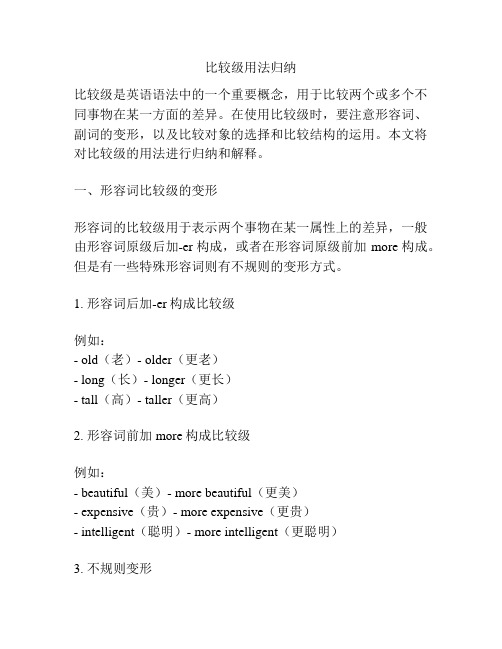
比较级用法归纳比较级是英语语法中的一个重要概念,用于比较两个或多个不同事物在某一方面的差异。
在使用比较级时,要注意形容词、副词的变形,以及比较对象的选择和比较结构的运用。
本文将对比较级的用法进行归纳和解释。
一、形容词比较级的变形形容词的比较级用于表示两个事物在某一属性上的差异,一般由形容词原级后加-er构成,或者在形容词原级前加more构成。
但是有一些特殊形容词则有不规则的变形方式。
1. 形容词后加-er构成比较级例如:- old(老)- older(更老)- long(长)- longer(更长)- tall(高)- taller(更高)2. 形容词前加more构成比较级例如:- beautiful(美)- more beautiful(更美)- expensive(贵)- more expensive(更贵)- intelligent(聪明)- more intelligent(更聪明)3. 不规则变形有一些形容词有一些不规则的变形方式,需要特别记忆,例如:- good(好)- better(更好)- bad(坏)- worse(更坏)- little(小)- less(更少)- many/much(多)- more(更多)二、副词比较级的变形副词的比较级变形方式和形容词类似,一般在副词后加-er,或者在副词前加more。
同样,也有一些特殊的副词比较级变形方式。
1. 副词后加-er构成比较级例如:- fast(快)- faster(更快)- soon(快)- sooner(更快)- late(晚)- later(更晚)2. 副词前加more构成比较级例如:- carefully(小心地)- more carefully(更小心地)- slowly(慢慢地)- more slowly(更慢慢地)- quietly(安静地)- more quietly(更安静地)3. 不规则变形有一些副词的比较级变形方式也是不规则的,例如:- well(好)- better(更好)- badly(糟糕地)- worse(更糟糕地)- little(少)- less(更少)- much(多)- more(更多)三、比较对象的选择在使用比较级时,需要选择适当的比较对象,即被比较的事物或者人。
《形容词比较级和最高级:规则变化与不规则变化全解析》

1.单音节形容词-一般情况:在词尾加-er构成比较级,加-est构成最高级。
例如:-原级:tall(高的),比较级是taller,最高级是tallest。
-原级:small(小的),比较级是smaller,最高级是smallest。
-以-e结尾的词:比较级直接加-r,最高级直接加-st。
例如:-原级:nice(美好的),比较级是nicer,最高级是nicest。
-原级:large(大的),比较级是larger,最高级是largest。
-以重读闭音节结尾,且末尾只有一个辅音字母的词:先双写这个辅音字母,再加-er构成比较级,加-est构成最高级。
例如:-原级:big(大的),比较级是bigger,最高级是biggest。
-原级:hot(热的),比较级是hotter,最高级是hottest。
-以“辅音字母+ y”结尾的词:变y为i,再加-er构成比较级,加-est构成最高级。
例如:-原级:happy(快乐的),比较级是happier,最高级是happiest。
-原级:easy(容易的),比较级是easier,最高级是easiest。
2.双音节形容词-一般情况:在前面加more构成比较级,加most构成最高级。
例如:-原级:careful(仔细的),比较级是more careful,最高级是most careful。
-原级:useful(有用的),比较级是more useful,最高级是most useful。
-以-y、-er、-ow、-ble结尾的双音节词:比较级可以在词尾加-er,最高级可以在词尾加-est,也可以采用前面加more/most的方式。
例如:-原级:clever(聪明的),比较级可以是cleverer或more clever,最高级可以是cleverest或most clever。
-原级:narrow(狭窄的),比较级可以是narrower或more narrow,最高级可以是narrowest或most narrow。
比较级最高级变化规则总结

比较级最高级变化规则总结在英语学习中,比较级和最高级是非常重要的语法知识点。
它们用于描述事物之间的程度差异,帮助我们更准确、生动地表达想法。
下面就来详细总结一下比较级和最高级的变化规则。
一、形容词和副词比较级和最高级的构成规则1、一般情况单音节词和少数双音节词,直接在词尾加 er 构成比较级,加 est 构成最高级。
例如:tall(高的) taller tallest例如:short(矮的) shorter shortest例如:fast(快的) faster fastest以不发音的 e 结尾的单音节词,直接在词尾加 r 构成比较级,加 st 构成最高级。
例如:nice(好的) nicer nicest例如:large(大的) larger largest以重读闭音节结尾,且末尾只有一个辅音字母的词,要先双写这个辅音字母,再加 er 构成比较级,加 est 构成最高级。
例如:big(大的) bigger biggest例如:hot(热的) hotter hottest例如:thin(瘦的) thinner thinnest2、多音节词和部分双音节词在词前加 more 构成比较级,加 most 构成最高级。
例如:beautiful(美丽的) more beautiful most beautiful例如:important(重要的) more important most important例如:difficult(困难的) more difficult most difficult3、不规则变化有些形容词和副词的比较级和最高级变化是不规则的,需要特别记忆。
例如:good(好的) better best例如:bad(坏的) worse worst例如:many / much(许多) more most例如:little(少的) less least例如:far(远的) farther / further farthest / furthest二、比较级和最高级的用法1、比较级的用法表示两者之间的比较,常用“than”连接。
形容词变比较级和最高级的规则
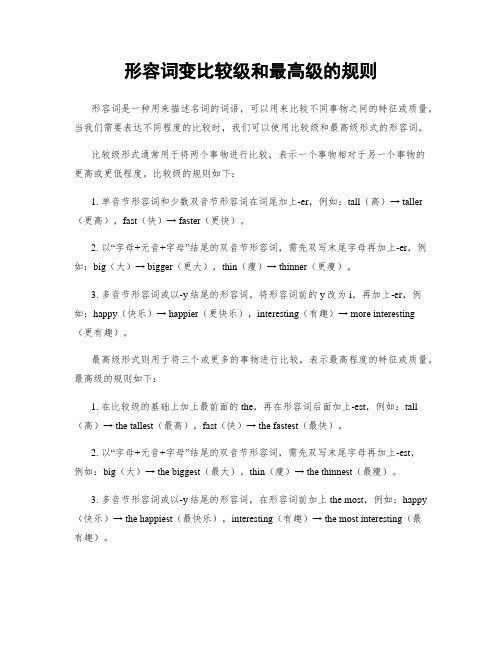
形容词变比较级和最高级的规则形容词是一种用来描述名词的词语,可以用来比较不同事物之间的特征或质量。
当我们需要表达不同程度的比较时,我们可以使用比较级和最高级形式的形容词。
比较级形式通常用于将两个事物进行比较,表示一个事物相对于另一个事物的更高或更低程度。
比较级的规则如下:1. 单音节形容词和少数双音节形容词在词尾加上-er,例如:tall(高)→ taller (更高),fast(快)→ faster(更快)。
2. 以“字母+元音+字母”结尾的双音节形容词,需先双写末尾字母再加上-er,例如:big(大)→ bigger(更大),thin(瘦)→ thinner(更瘦)。
3. 多音节形容词或以-y结尾的形容词,将形容词前的y改为i,再加上-er,例如:happy(快乐)→ happier(更快乐),interesting(有趣)→ more interesting(更有趣)。
最高级形式则用于将三个或更多的事物进行比较,表示最高程度的特征或质量。
最高级的规则如下:1. 在比较级的基础上加上最前面的the,再在形容词后面加上-est,例如:tall (高)→ the tallest(最高),fast(快)→ the fastest(最快)。
2. 以“字母+元音+字母”结尾的双音节形容词,需先双写末尾字母再加上-est,例如:big(大)→ the biggest(最大),thin(瘦)→ the thinnest(最瘦)。
3. 多音节形容词或以-y结尾的形容词,在形容词前加上the most,例如:happy (快乐)→ the happiest(最快乐),interesting(有趣)→ the most inter esting(最有趣)。
请按照上述规则使用适当的变形词形,加强描述名词的程度。
这样可以让文章更具比较效果,提升文笔的生动性和表达能力。
记住,在使用比较级和最高级时,要根据实际需要进行恰当选择,使句子更准确、流畅、富有表现力。
比较级最高级变化规则总结
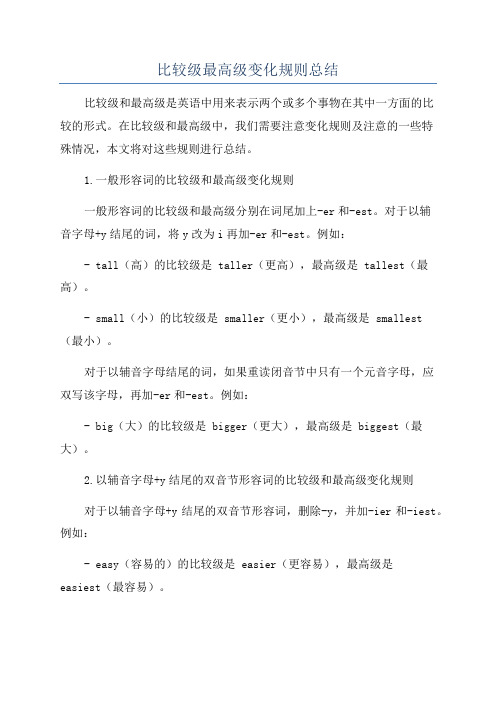
比较级最高级变化规则总结比较级和最高级是英语中用来表示两个或多个事物在其中一方面的比较的形式。
在比较级和最高级中,我们需要注意变化规则及注意的一些特殊情况,本文将对这些规则进行总结。
1.一般形容词的比较级和最高级变化规则一般形容词的比较级和最高级分别在词尾加上-er和-est。
对于以辅音字母+y结尾的词,将y改为i再加-er和-est。
例如:- tall(高)的比较级是 taller(更高),最高级是 tallest(最高)。
- small(小)的比较级是 smaller(更小),最高级是 smallest(最小)。
对于以辅音字母结尾的词,如果重读闭音节中只有一个元音字母,应双写该字母,再加-er和-est。
例如:- big(大)的比较级是 bigger(更大),最高级是 biggest(最大)。
2.以辅音字母+y结尾的双音节形容词的比较级和最高级变化规则对于以辅音字母+y结尾的双音节形容词,删除-y,并加-ier和-iest。
例如:- easy(容易的)的比较级是 easier(更容易),最高级是easiest(最容易)。
- happy(快乐的)的比较级是 happier(更快乐),最高级是happiest(最快乐)。
3.双音节和部分多音节形容词的比较级和最高级变化规则对于双音节和部分多音节形容词,使用 more和most来表示比较级和最高级。
例如:- famous(著名的)的比较级是 more famous(更著名),最高级是most famous(最著名)。
- intelligent(聪明的)的比较级是 more intelligent(更聪明),最高级是 most intelligent(最聪明)。
4.部分特殊形容词的比较级和最高级变化规则一些形容词比较级和最高级的变化规则与一般规则不同,例如:- good(好的)的比较级是 better(更好),最高级是 best(最好)。
- bad(坏的)的比较级是 worse(更坏),最高级是 worst(最坏)。
比较级和最高级变化规则

比较级和最高级变化规则比较级和最高级的变化规则:比较级就是将二者进行比较产生的词形,是由形容词或副词原级转化而来。
英语句子中,将比较两个主体的方法叫做”比较句型”。
最高级表示三者或三者以上的人或物进行比较时,用最高级。
在含有最高级的句子中,常有一个in/of/among短语来表示比较范围。
比较级的变化规则如下:单音节形容词和部分双音节词(大多是以y、ly、er、ow、ble结尾的双音节形容词) , 一般在词尾加-er。
例如:tall(taller)、great ( greater)、small ( smaller)、clean (cleaner)等等。
以字母e结尾的词,在词尾直接加-r。
例如:fine ( finer)、nice (nicer)、wide (wider)等等。
以一个元音加一个辅音结尾的词,且元音发短音时,双写尾字母,再加er。
例如:fat(fatter)、big (bigger)、hot (hotter)、red (redder)等等。
少数以y,er, ow,b1e结尾的双音节词,末尾加er;以y结尾的词如果y前是辅音字母,则变y为i,再加er;以e结尾的词只加r。
例如:clever ( cleverer)、narrow(narrower)、able (abler)、easy (easier)等等。
其它双音节和多音节词皆在前面加单词more。
例如:careful (more careful )、difficult (more difficult)、delicious ( more delicious)等等。
有些词的比较级变化不规则,则需要特殊记忆。
例如:good/well(better )、bad ( worse)、many/much (more)、little (less)、far( farther)等等。
最高级的变化规则如下:一般在词尾直接加er或est,例如,tall-taller-tallest,long-longer-longest。
形容词比较级和最高级变化规则
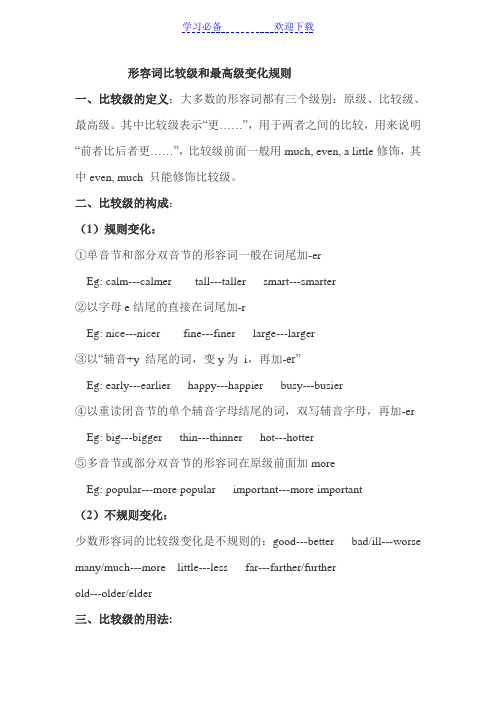
形容词比较级和最高级变化规则一、比较级的定义:大多数的形容词都有三个级别:原级、比较级、最高级。
其中比较级表示“更……”,用于两者之间的比较,用来说明“前者比后者更……”,比较级前面一般用much, even, a little修饰,其中even, much 只能修饰比较级。
二、比较级的构成:(1)规则变化:①单音节和部分双音节的形容词一般在词尾加-erEg: calm---calmer tall---taller smart---smarter②以字母e结尾的直接在词尾加-rEg: nice---nicer fine---finer large---larger③以“辅音+y 结尾的词,变y为i,再加-er”Eg: early---earlier happy---happier busy---busier④以重读闭音节的单个辅音字母结尾的词,双写辅音字母,再加-er Eg: big---bigger thin---thinner hot---hotter⑤多音节或部分双音节的形容词在原级前面加moreEg: popular---more popular important---more important(2)不规则变化:少数形容词的比较级变化是不规则的:good---better bad/ill---worse many/much---more little---less far---farther/furtherold---older/elder三、比较级的用法:(一)当两个人或事物(A和B)进行比较时,我们需要用到形容词(副词)的原级或者比较级1.表达“A和B一样”,用as…as的结构。
公式: A+be动词+as+形容词原级+as…+BA+实义动词+as+副词原级+as…+BEg I am as tall as you.我和你一样高。
He runs as fast as I. 他跑得和我一样快。
比较级的变化规则
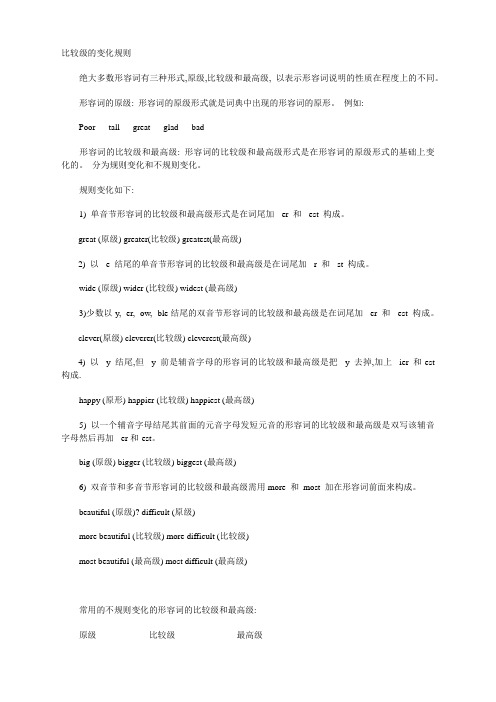
比较级的变化规则绝大多数形容词有三种形式,原级,比较级和最高级, 以表示形容词说明的性质在程度上的不同。
形容词的原级: 形容词的原级形式就是词典中出现的形容词的原形。
例如:Poor tall great glad bad形容词的比较级和最高级: 形容词的比较级和最高级形式是在形容词的原级形式的基础上变化的。
分为规则变化和不规则变化。
规则变化如下:1) 单音节形容词的比较级和最高级形式是在词尾加-er 和-est 构成。
great (原级) greater(比较级) greatest(最高级)2) 以-e 结尾的单音节形容词的比较级和最高级是在词尾加-r 和-st 构成。
wide (原级) wider (比较级) widest (最高级)3)少数以-y, -er, -ow, -ble结尾的双音节形容词的比较级和最高级是在词尾加-er 和-est 构成。
clever(原级) cleverer(比较级) cleverest(最高级)4) 以-y 结尾,但-y 前是辅音字母的形容词的比较级和最高级是把-y 去掉,加上-ier 和-est 构成.happy (原形) happier (比较级) happiest (最高级)5) 以一个辅音字母结尾其前面的元音字母发短元音的形容词的比较级和最高级是双写该辅音字母然后再加-er和-est。
big (原级) bigger (比较级) biggest (最高级)6) 双音节和多音节形容词的比较级和最高级需用more 和most 加在形容词前面来构成。
beautiful (原级)? difficult (原级)more beautiful (比较级) more difficult (比较级)most beautiful (最高级) most difficult (最高级)常用的不规则变化的形容词的比较级和最高级:原级比较级最高级good better bestmany more mostmuch more mostbad worse worstlittle less leastill worse worstfar farther(further)farthest(furthest)形容词前如加less 和lest 则表示"较不"和"最不"important 重要less important 较不重要lest important 最不重要形容词比较级的用法:形容词的比较级用于两个人或事物的比较,其结构形式如下:主语+谓语(系动词)+ 形容词比较级+than+ 对比成分。
形容词和副词比较级的变化规则
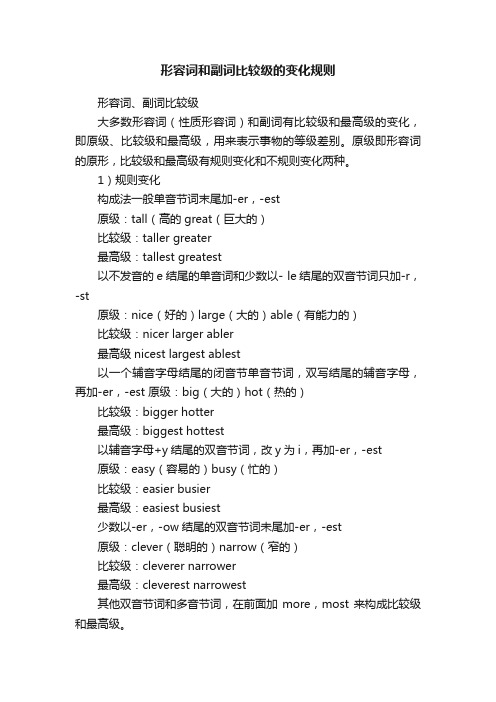
形容词和副词比较级的变化规则形容词、副词比较级大多数形容词(性质形容词)和副词有比较级和最高级的变化,即原级、比较级和最高级,用来表示事物的等级差别。
原级即形容词的原形,比较级和最高级有规则变化和不规则变化两种。
1)规则变化构成法一般单音节词末尾加-er,-est原级:tall(高的great(巨大的)比较级:taller greater最高级:tallest greatest以不发音的e结尾的单音词和少数以- le结尾的双音节词只加-r,-st原级:nice(好的)large(大的)able(有能力的)比较级:nicer larger abler最高级nicest largest ablest以一个辅音字母结尾的闭音节单音节词,双写结尾的辅音字母,再加-er,-est 原级:big(大的)hot(热的)比较级:bigger hotter最高级:biggest hottest以辅音字母+y结尾的双音节词,改y为i,再加-er,-est原级:easy(容易的)busy(忙的)比较级:easier busier最高级:easiest busiest少数以-er,-ow结尾的双音节词未尾加-er,-est原级:clever(聪明的)narrow(窄的)比较级:cleverer narrower最高级:cleverest narrowest其他双音节词和多音节词,在前面加more,most来构成比较级和最高级。
原级:important(重要的)easily(容易地)比较级:more important more easily最高级:most important most easily2)不规则变化原级:good(好的)bad(坏的)比较级:better worse最高级:best worst副词:1) 时间和频度副词: now, then, often, always, usually, early, today, lately, next, last, already, generally, frequently, seldom, ever, never ,yet ,soon ,too, immediately, hardly, finally, shortly, before, ago, sometimes, yesterday. 2) 地点副词: here, there, everywhere, anywhere, in, out, inside, outside, above, below, d own, back, forward, home, upstairs, downstairs, across, along, round , around, near, off, past, up, away, on. 3) 方式副词: carefully, properly, anxiously, sudde nly, normally, fast, well, calmly, politely, proudly, softly, warmly 4) 程度副词: much ,little, very, rather, so, too, still, quite, perfectly, enough, extremely, entirel y, almost, slightly. 5) 疑问副词: how, when, where, why. 6) 关系副词: when, where, why. 7) 连接副词: how, when, where, why, whether.As…as的一般用法:其基本意思为“与…一样”,其中的第一个as为副词,其后通常接形容词或副词(用原级),第二个as可用作介词(后接名词或代词)或连词(后接从句)。
比较级的变化规则
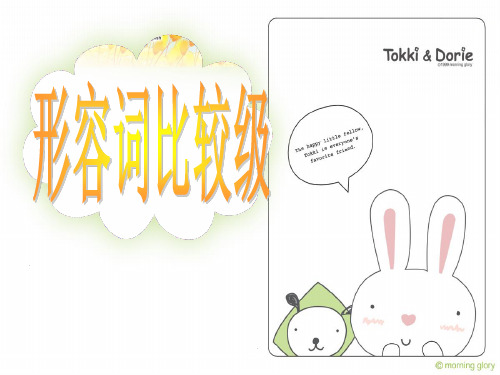
A
18
选择练习。 1.Lucy is _ta_l_le_r_(更高一些)then Lily. 2.--I have_f_e_w_e_r(更少一些)books than he. 3.Peter has_m__o_re__(更多的)keys
than Lingling. 4.My coat is_b_ig_g_e_r__(更大的)than
A . on B.in C. of D.to 3.Please talk about them___your friends.
A.with B.at C.andlong DC.l.for 4.She has__butter in her fridge.
A.fewer B.few C.less D.small
A
15
三、翻译句子。
1.我比Lily高。I am taller than Lily.
2.Tom 比我小。
Tom is younger than me.
3.他比他哥哥强壮。
He is stronger than his brother.
4.北京比广州大。
Beijing is bigger than Guangzhou.
黑色炸弹炸敌人20
钻石 50 皇冠 100 金币30 A
14
选择练习。 1.Jim's arms are shorter than___.
A.me B .I C.mine D.my 2.--In__box are there more pens? .---Blue box.
A . which B.what C. where D.how 3.There __less water in the bottle A.are B.is C.has long C.lD.have
比较级的变化规则

比较级的变化规则绝大多数形容词有三种形式,原级,比较级和最高级, 以表示形容词说明的性质在程度上的不同。
形容词的原级: 形容词的原级形式就是词典中出现的形容词的原形。
例如:Poor tall great glad bad形容词的比较级和最高级: 形容词的比较级和最高级形式是在形容词的原级形式的基础上变化的。
分为规则变化和不规则变化。
规则变化如下:1) 单音节形容词的比较级和最高级形式是在词尾加-er 和-est 构成。
great (原级) greater(比较级) greatest(最高级)2) 以-e 结尾的单音节形容词的比较级和最高级是在词尾加-r 和-st 构成。
wide (原级) wider (比较级) widest (最高级)3)少数以-y, -er, -ow, -ble结尾的双音节形容词的比较级和最高级是在词尾加-er 和-est 构成。
clever(原级) cleverer(比较级) cleverest(最高级)4) 以-y 结尾,但-y 前是辅音字母的形容词的比较级和最高级是把-y 去掉,加上-ier 和-est 构成.happy (原形) happier (比较级) happiest (最高级)5) 以一个辅音字母结尾其前面的元音字母发短元音的形容词的比较级和最高级是双写该辅音字母然后再加-er和-est。
big (原级) bigger (比较级) biggest (最高级)6) 双音节和多音节形容词的比较级和最高级需用more 和most 加在形容词前面来构成。
beautiful (原级)? difficult (原级)more beautiful (比较级) more difficult (比较级)most beautiful (最高级) most difficult (最高级)常用的不规则变化的形容词的比较级和最高级:原级比较级最高级good better bestmany more mostmuch more mostbad worse worstlittle less leastill worse worstfar farther(further)farthest(furthest)形容词前如加less 和lest 则表示"较不"和"最不"important 重要less important 较不重要lest important 最不重要形容词比较级的用法:形容词的比较级用于两个人或事物的比较,其结构形式如下:主语+谓语(系动词)+ 形容词比较级+than+ 对比成分。
比较级和最高级的变化规则表格总结
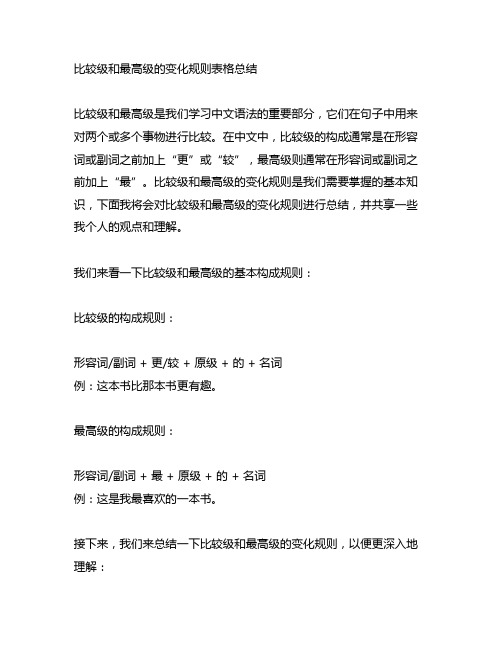
比较级和最高级的变化规则表格总结比较级和最高级是我们学习中文语法的重要部分,它们在句子中用来对两个或多个事物进行比较。
在中文中,比较级的构成通常是在形容词或副词之前加上“更”或“较”,最高级则通常在形容词或副词之前加上“最”。
比较级和最高级的变化规则是我们需要掌握的基本知识,下面我将会对比较级和最高级的变化规则进行总结,并共享一些我个人的观点和理解。
我们来看一下比较级和最高级的基本构成规则:比较级的构成规则:形容词/副词 + 更/较 + 原级 + 的 + 名词例:这本书比那本书更有趣。
最高级的构成规则:形容词/副词 + 最 + 原级 + 的 + 名词例:这是我最喜欢的一本书。
接下来,我们来总结一下比较级和最高级的变化规则,以便更深入地理解:1. 单音节词和部分双音节词的比较级和最高级的变化规则:- 比较级:原级 + er- 最高级:原级 + est例:old - older - oldest2. 部分双音节词和多音节词的比较级和最高级的变化规则:- 比较级:more + 原级- 最高级:most + 原级例:beautiful - more beautiful - most beautiful3. 特殊形式的比较级和最高级的变化规则:- 比较级:good - better- 最高级:good - best例:She is a better player than I am.通过以上总结,我对比较级和最高级的变化规则有了更全面、深刻的理解。
在实际运用中,我们需要根据词语的词性和音节数来灵活运用比较级和最高级的变化规则,以达到更准确、丰富的表达。
我们也要注意一些特殊形式的比较级和最高级,加强对这些词语的记忆和运用。
对于我个人来说,比较级和最高级的变化规则在写作和交流中起着至关重要的作用。
通过掌握这些规则,我可以更准确、更生动地描述事物之间的差异和优劣,使我的表达更加丰富有力。
在学习中文的过程中,我也深感比较级和最高级的变化规则是我们需要反复练习和应用的知识点,只有通过不断的实践才能真正掌握这一语法知识。
比较级变形规则
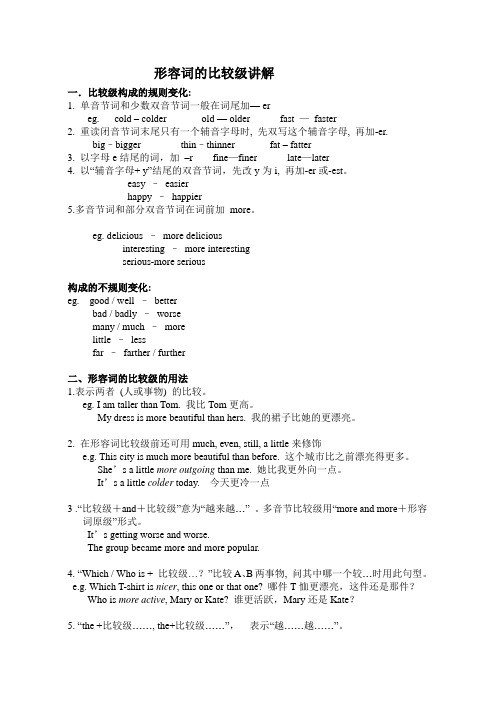
形容词的比较级讲解一.比较级构成的规则变化:1. 单音节词和少数双音节词一般在词尾加— ereg. cold – colder old — older fast —faster2. 重读闭音节词末尾只有一个辅音字母时, 先双写这个辅音字母, 再加-er.big–bigger thin–thinner fat – fatter3. 以字母e结尾的词,加–r fine—finer late—later4. 以“辅音字母+ y”结尾的双音节词,先改y为i, 再加-er或-est。
easy –easierhappy –happier5.多音节词和部分双音节词在词前加more。
eg. delicious –more deliciousinteresting –more interestingserious-more serious构成的不规则变化:eg. good / well –betterbad / badly –worsemany / much –morelittle –lessfar –farther / further二、形容词的比较级的用法1.表示两者(人或事物) 的比较。
eg. I am taller than Tom. 我比Tom更高。
My dress is more beautiful than hers. 我的裙子比她的更漂亮。
2. 在形容词比较级前还可用much, even, still, a little来修饰e.g. This city is much more beautiful than before. 这个城市比之前漂亮得更多。
She’s a little more outgoing than me. 她比我更外向一点。
It’s a little colder today. 今天更冷一点3 .“比较级+and+比较级”意为“越来越…”。
多音节比较级用“more and more+形容词原级”形式。
形容词比较级的变化规则

形容词比较级的变化规则
一般在词尾加er,以不发音的字母e结尾的加r,以重读闭音节结尾的词,而词尾只有一个辅音字母时,先双写这一辅音字母,再加er。
以辅音字母加y结尾的双音节词先变y为i再加er。
多音节词在词前加more,另外还有一些不规则变化如good变为better。
扩展资料
规则变化:
1)单音节词末尾加-er(比较级),-est(最高级)
原级比较级最高级great greater greatest small smaller smallest clean cleaner cleanest。
2)单音节如以e结尾,只加-r(比较级),-st(最高级)。
fine finer finest nice nicer nicest wide wider widest。
3)闭音节单音节词如末尾只有一个辅音字母,须先双写这个辅音字母,再加-er(比较级),-est(最高级)。
动词比较级的变化规则

动词比较级的变化规则动词比较级是英语中一个非常重要的语法结构,它用于比较两个或多个事物之间的程度、大小、高低等差异。
了解动词比较级的变化规则对于学习英语是非常重要的。
一般情况下,动词比较级的变化规则如下:1. 一般情况下,在动词原形后面加上-er,如:big-bigger, tall-taller, fast-faster。
2. 对于以一个元音字母加上一个辅音字母结尾的单词,需要双写最后一个辅音字母,并在后面加上-er,如:big-bigger, hot-hotter。
3. 对于以“e”结尾的单词,只需要在其末尾加上-r即可,如:large-larger, fine-finer。
4. 对于以“y”结尾的单词,如果前面是元音字母,则直接在末尾添加-r即可;如果前面是辅音字母,则将“y”改为“i”,再加上-er。
例如:play-player, happy-happier。
5. 有些单词不符合以上规则,需要进行不规则变化。
例如:good-better, bad-worse, far-further/farther。
除了以上几种情况外,还有一些特殊情况需要注意:1. 双音节及多音节词的比较级前面需要加上more,如:beautiful-more beautiful, expensive-more expensive。
2. 部分不规则动词的比较级变化需要记忆,如:come-came-come-become-became-become。
3. 有些单词只有最高级,没有比较级,如:perfect、unique、dead 等。
总之,在学习英语过程中,了解动词比较级的变化规则是非常重要的。
只有掌握了这些规则,才能更加准确地表达自己的意思,并更好地理解他人所说的话。
- 1、下载文档前请自行甄别文档内容的完整性,平台不提供额外的编辑、内容补充、找答案等附加服务。
- 2、"仅部分预览"的文档,不可在线预览部分如存在完整性等问题,可反馈申请退款(可完整预览的文档不适用该条件!)。
- 3、如文档侵犯您的权益,请联系客服反馈,我们会尽快为您处理(人工客服工作时间:9:00-18:30)。
形容词的比较级讲解
一.比较级构成的规则变化:
1. 单音节词和少数双音节词一般在词尾加— er
eg. cold – colder old — older fast —faster
2. 重读闭音节词末尾只有一个辅音字母时, 先双写这个辅音字母, 再加-er.
big–bigger thin–thinner fat – fatter
3. 以字母e结尾的词,加–r fine—finer late—later
4. 以“辅音字母+ y”结尾的双音节词,先改y为i, 再加-er或-est。
easy –easier
happy –happier
5.多音节词和部分双音节词在词前加more。
eg. delicious –more delicious
interesting –more interesting
serious-more serious
构成的不规则变化:
eg. good / well –better
bad / badly –worse
many / much –more
little –less
far –farther / further
二、形容词的比较级的用法
1.表示两者(人或事物) 的比较。
eg. I am taller than Tom. 我比Tom更高。
My dress is more beautiful than hers. 我的裙子比她的更漂亮。
2. 在形容词比较级前还可用much, even, still, a little来修饰
e.g. This city is much more beautiful than before. 这个城市比之前漂亮得更多。
She’s a little more outgoing than me. 她比我更外向一点。
It’s a little colder today. 今天更冷一点
3 .“比较级+and+比较级”意为“越来越…”。
多音节比较级用“more and more+形容
词原级”形式。
It’s getting worse and worse.
The group became more and more popular.
4. “Which / Who is + 比较级…?”比较A、B两事物, 问其中哪一个较…时用此句型。
e.g. Which T-shirt is nicer, this one or that one? 哪件T恤更漂亮,这件还是那件?
Who is more active, Mary or Kate? 谁更活跃,Mary还是Kate?
5. “the +比较级……, the+比较级……”,表示“越……越……”。
The more money you make, the more you spend. 钱你赚得越多,花得越多。
The sooner,the better. 越快越好。
三、比较两者其他用法
1. 两者在某一方面相同的基本句型
“as +形容词或副词原形+as”“…跟…一样”
e.g. I think science is as important as math. 我认为科学跟数学一样重要。
Tom runs as fast as Jim. 汤姆跑的跟吉姆一样快。
2. 一方在某一方面不及对方的基本句型
“not as/so +形容词或副词原形+as”“…不如…”
e.g. He is not as/ so tall as his brother. 他没有他兄弟那么高
Tom does’t run as fast as Jim. 汤姆跑的跟不如吉姆快。
Ⅱ. 形容词比较级的用法:表示两者(人或物)的比较。
⒈比较级+than从句表示两者比较( A … 比较级+than B )
①. 他比我高。
He is ________ (tall) than me.
②. 他的头发比我的短。
His hair is ________(short) than _________.
He has ________ (short) hair than ________.
③. Tom比我胖。
Tom is _____ (fat) than me.
④. 谁跑得快些,Lucy 还是Lily?Who runs _________, Lucy or Lily?
⑤. 英语比语文重要。
English is _______________ (important) than Chinese.
⑥. 我来的比你晚。
I come _______ (late) than you.
⑦. 他比你小2岁。
He’s 2 years _________ than you.
⒉表示两者“相等”用,as+形容词原级+比较对象: (A … as 原级 B )
①他和我一样高。
He is as ________ (tall) as I/me.
②英语比语文重要。
English is as _______________ (important) as Chinese.
③他的头发和我的头发一样长。
His hair is ________ ________ _______ mine.
④他学习和你一样努力。
He works _______ hard ______ you.
⒊表示“不如”,“不相等”时,用“not+as/so+形容词原级+as+比较对象”。
①他没我高。
He is ______ ________ (tall) as me.
②今天没有昨天暖和。
Today is ______ _______ _______(warm) _______ yesterday.
=Yesterday ______ ________ than today.
③他昨天来得没有我早。
He _________ come ________ early as I (did) yesterday.
比较级前可用much / a lot / far(… 得多),a little(稍微),still, no, even(甚至), any 等表示程度;
形容词、副词前如有:very, too, quite(非常), rather(相当)等修饰,一般用原级。
比较:He is much ___________( well) today. It’s much ____________ (expensive).
He is very __________ (well) today. It’s too ___________ (expensive)
△⒋“比较级+and+ 比较级”表示“越来越…”
天气越来越冷了。
It’s getting ______ and _______(cold)
△⒌“The+ 比较级…,the+ 比较级…”表示“越…,就越…
越多越好The ________, the _______.。
